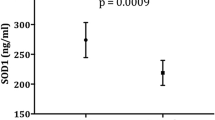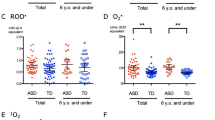Abstract.
There is great evidence in recent years that oxygen free radicals play an important role in the pathophysiology of many neuropsychiatric disorders. The present study was performed to assess the changes in red blood cells thiobarbituric acid-reactive substances (TBARS) levels, and superoxide dismutase (SOD), catalase (CAT), adenosine deaminase (ADA) and xanthine oxidase (XO) activities in patients with autism (n = 27) compared to age- and sex-matched normal controls (n = 26). In the autistic group, increased TBARS levels (p < 0.001) and XO (p < 0.001) and SOD (p < 0.001) activity, decreased CAT (p < 0.001) activity and unchanged ADA activity were detected. It is proposed that antioxidant status may be changed in autism and this new situation may induce lipid peroxidation. These findings indicated a possible role of increased oxidative stress and altered enzymatic antioxidants, both of which may be relevant to the pathophysiology of autism.
Similar content being viewed by others
Author information
Authors and Affiliations
Corresponding author
Rights and permissions
About this article
Cite this article
Zoroglu, S.S., Armutcu, F., Ozen, S. et al. Increased oxidative stress and altered activities of erythrocyte free radical scavenging enzymes in autism. European Archives of Psychiatry and Clinical Neurosciences 254, 143–147 (2004). https://doi.org/10.1007/s00406-004-0456-7
Received:
Accepted:
Issue Date:
DOI: https://doi.org/10.1007/s00406-004-0456-7




